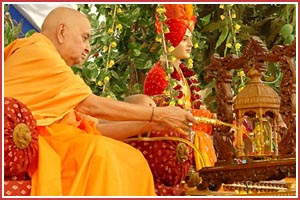 Bhagatji
Maharaj's Birthday - The Swaminarayan Sampradaya also
celebrates the birth of Bhagwan Swaminarayan's second spiritual
successor on this day.
Bhagatji
Maharaj's Birthday - The Swaminarayan Sampradaya also
celebrates the birth of Bhagwan Swaminarayan's second spiritual
successor on this day.
This festival celebrates the arrival
of spring on Fagun sud Purnima. Also known as Falgunika, people
celebrate the changing season and the beauty associated with spring
blossoms by spraying color.
In the Gita (10/35), Shri Krishna proclaims
spring as the foremost season and one of his Vibhutis -forms:
Rutunaam kusumaakaraha
The ritual of offering roasted grain
to Agni - fire-deity is known as Navaanineshti. In Sanskrit, roasted
grain is Holaakaa, from which the Hindi 'Holi' is derived. Since
Vedic times people availed the newly harvested grain only after
offering to the devas. This offering of new grain is Holi.
The Bhavishyottara Puran associates
Holi both with man and yagna. Therefore the yagna performed for
man's salvation is Holi.
Holi's Origin
There are several stories associated
with Holi.
Import
Immersed in maya, pained and tainted by Maya, man is exhorted to
vanquish his base instincts. The true Holi is in eradicating these
instincts and simultaneously being 'colored' by the Lord's 'color.'
Ritual
People burn Holika's effigy. Hence the festival is also known as
Holikaa Dahan. It is celebrated in Mewar and Marwad in Rajasthan
with as much fervor as Diwali in Gujarat. People hurl gulal powder
on each other in the streets.
Also known as Pushpadolotsav - Festival
of Flowers, it is celebrated on the day after Holi, on Fagun
Vad 1.
Origin
Once Arjun accompanied Shri Krishna to Raivatachal - Mt.Girnar.
Here the Lord pleased the Yadavas with divine sports. In turn, to
please him, the joyous Yadavas made a swing of flowers. They then
seated Shri Krishna and Arjun on the hindolo (swing), performed
pujan and swung the hindolo. Henceforth the two became renowned
as Nar-Narayan and the Pushpadolotsav came into being.
Import
By performing actions in accordance to the rules of Dharma, to please
the Lord, the devotee symbolically brings the Lord nearer his heart.
This is akin to pulling the hindolo swing towards himself. When
the devotee falters in his devotion, the Lord moves away, symbolised
by the swing moving away. Therefore the devotee strives to offer
better bhakti, which results in the Lord's incessant proximity.
Ritual
Devotees construct a hindolo of flowers, instal the Lord's murti
and swing Him. They also spray colored water on each other.
On Fuldol, people traditionally offer
fagwaa roasted chick peas (chana), dates and popcorn to God and
partake of the prasad.
In the Swaminarayan Sampraday, the
women devotees of north Gujarat requested Bhagwan Swaminarayan for
unique fagwaa in the Fuldol of Samvat 1868 (1812 CE), in Sarangpur.
It comprised lofty sentiments in the form of a prayer to be delivered
from maya:
Maha balvant maya tamaari, jene aawariya narnaari...
The prayer, versified by Nishkulanand Swami in the Bhaktachintamani
(ch.64), is sung regularly even today.
Bhagwan Swaminarayan celebrated Fuldol
in many different places during His period. Of these, the two most
prominent were in Samvat 1872 (1816 CE), in Vartal and in Samvat
1868 (1812 CE), in Sarangpur. Pramukh Swami Maharaj celebrates this
festival on a huge scale in Sarangpur in Saurashtra, with devotion
and fervor.
In the Swaminarayan Sampradaya's shikharbaddh
mandirs, Fuldol is traditionally celebrated with immense fervor
after the Rajbhog Arti, around 11 a.m. A water hose attached to
Bhagwan Swaminarayan's murti in the central shrine sprays colored
and fragrant water on the devotees. Besides being solaced they feel
spiritually charged in being graced with sanctified water by God.





